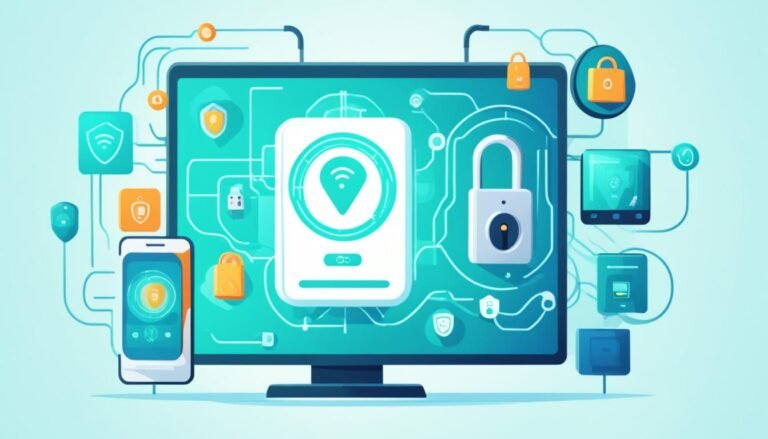The Future of Financial Education and E-Learning
Did you know that only 42% of adults worldwide are financially literate?
Financial literacy programs have traditionally relied on in-person workshops and classroom-based learning. However, with the rise of digitalization, online finance courses and e-learning platforms are revolutionizing the way we approach financial education. The demand for accessible and personalized financial learning methods is higher than ever before.
In this article, we will explore the benefits and challenges of digital tools in financial education, discuss effective ways to deliver digital financial education initiatives, highlight the importance of financial literacy in the United States, examine the impact of financial literacy on well-being, and uncover the role of financial education in lifelong financial independence.
Get ready to discover the future of financial education and how e-learning is reshaping the way we learn about money!
Key Takeaways:
- The digital delivery of financial education is transforming the way we learn about money.
- Digital tools offer advantages such as increased access to financial information and improved training opportunities.
- Effective digital financial education initiatives focus on providing access to information, training, and developing skills and confidence.
- Financial literacy is crucial for individuals to make informed financial decisions and achieve long-term financial well-being.
- Financial education in schools plays a vital role in equipping students with lifelong financial skills and knowledge.
The Benefits and Challenges of Digital Tools in Financial Education
Digital tools play a crucial role in delivering financial education, offering numerous advantages for learners. These tools provide increased access to financial information and advice, enabling individuals to make informed decisions about their money. They also offer improved training opportunities, allowing users to develop essential financial skills and confidence. By leveraging digital tools, financial education initiatives can effectively address common behavioral biases that impact financial decision-making.
One of the key advantages of digital tools in financial education is their ability to break down geographical barriers. With online resources and platforms, learners can access financial education materials from anywhere at any time, eliminating the limitation of physical location. This accessibility is particularly beneficial for individuals in remote areas or those with physical constraints that prevent them from attending traditional in-person classes.
Digital tools also provide personalized learning experiences, catering to individuals with different skill levels and learning styles. Through interactive modules, quizzes, and simulations, learners can actively engage with the content, enhancing their comprehension and retention of financial concepts. Moreover, these tools allow users to track their progress, identify areas of improvement, and receive personalized recommendations for further learning.
**Quote:** “Digital tools offer a dynamic and immersive learning experience, fostering active engagement and retention among learners.” – Financial Education Expert
Despite the many advantages, there are challenges associated with the use of digital tools in financial education. One of the primary challenges is ensuring the quality and reliability of online resources. With the abundance of information available on the internet, it is crucial to curate and provide accurate and trustworthy financial content to learners. Educators and organizations must carefully vet and select digital resources that meet educational standards and align with the specific learning objectives.
Another challenge is addressing the needs of vulnerable learners who may have limited digital literacy skills or lack access to digital devices and stable internet connections. To ensure inclusivity, financial education initiatives must consider alternative delivery methods such as offline materials, partnerships with community organizations, or mobile-friendly applications that can be accessed even with limited connectivity.
To maximize the impact of digital financial education initiatives, effective design, monitoring, and evaluation are essential. It is crucial to design user-friendly interfaces, intuitive navigation, and engaging content to enhance user experience and promote active learning. Continuous monitoring and evaluation help identify areas for improvement, measure the effectiveness of digital tools, and inform future enhancements and refinements.
Advantages of Digital Tools in Financial Education:
- Increased access to financial information and advice
- Improved training opportunities
- Development of essential financial skills and confidence
- Personalized learning experiences
- Engagement with dynamic and immersive content
Challenges of Digital Tools in Financial Education:
- Ensuring the quality and reliability of online resources
- Addressing the needs of vulnerable learners
- Overcoming limited digital literacy skills and access to devices or stable internet connections
Overall, digital tools play a vital role in advancing financial education by making it more accessible, engaging, and personalized. As technology continues to evolve, leveraging digital platforms and resources will be crucial in equipping individuals with the necessary financial literacy skills and empowering them to make informed financial decisions.
Delivering Digital Financial Education Initiatives
Effective digital financial education initiatives play a crucial role in improving access to financial information, providing training opportunities, and developing the skills and confidence needed to make informed financial decisions. In today’s digital age, these initiatives leverage various online platforms and tools to reach and engage a wide audience.
One of the key advantages of digital financial education is the enhanced access to financial information and advice it offers. Through websites, social media platforms, and mobile apps, individuals can easily access a wealth of resources, tools, and expert insights. This ensures that they have the necessary knowledge to navigate complex financial topics and make informed choices that align with their goals and aspirations.
Moreover, digital solutions enable the delivery of interactive and personalized training programs. Online training courses and modules can be tailored to individual needs, allowing learners to progress at their own pace. These initiatives help individuals acquire and develop the skills required to manage their finances effectively, such as budgeting, saving, investing, and planning for the future.
“Digital financial education initiatives provide individuals with the tools and knowledge they need to succeed in today’s complex financial landscape.”
By leveraging technology, digital financial education initiatives also address the issue of accessibility. Online platforms can reach individuals in remote areas, marginalized communities, and underserved populations who may have limited access to traditional financial education resources. This inclusivity ensures that everyone has the opportunity to enhance their financial literacy and improve their financial well-being.
The COVID-19 pandemic has further highlighted the importance of digital tools in delivering financial education. With physical distancing measures in place, digital platforms have emerged as the primary means of accessing financial literacy resources. They have become indispensable in ensuring continuous access to training and educational materials, even in challenging times.
To illustrate the impact of digital financial education initiatives, the table below highlights key statistics and trends:
| Key Statistics | Benefits |
|---|---|
| Increased access to financial information | Empowers individuals to make informed decisions |
| Personalized training opportunities | Develops skills and confidence tailored to individual needs |
| Reach marginalized and underserved populations | Promotes financial inclusivity and equity |
| Adaptability during challenging times | Ensures continuous access to financial education resources |
These statistics underscore the transformative power of digital financial education initiatives in improving financial literacy and well-being. Through accessible and innovative digital solutions, individuals can gain the knowledge, skills, and confidence needed to navigate the complexities of personal finance successfully.
Designing, Monitoring, and Evaluating Digital Financial Education Initiatives
When it comes to digital financial education initiatives, careful planning and thoughtful execution are key. Designing these initiatives involves considering the target audience, learning objectives, and the integration of innovative technologies. By crafting tailored experiences, we can effectively engage learners and provide them with the knowledge and skills they need to make informed financial decisions.
However, designing is just the beginning. To ensure the effectiveness and impact of these initiatives, monitoring and evaluation are crucial. By collecting data on outcomes, user feedback, and participation rates, we can gain valuable insights into the effectiveness of our digital financial education programs. This information allows us to make data-driven decisions and continuously improve the learning experience.
Let’s take a closer look at the important steps involved in designing, monitoring, and evaluating digital financial education initiatives:
Step 1: Identify the Target Audience and Learning Objectives
Before designing any educational program, it’s essential to clearly define the target audience and learning objectives. Understanding the specific needs, preferences, and goals of the learners allows us to tailor the content and delivery methods effectively. By aligning the learning objectives with the target audience, we can create a meaningful and relevant learning experience.
Step 2: Leverage Innovative Technologies and Platforms
To enhance engagement and interactivity, it’s essential to leverage innovative technologies and platforms. These technologies can include mobile apps, interactive learning modules, gamification elements, and virtual reality simulations. By embracing these tools, we can create immersive learning experiences that resonate with learners and promote active participation.
Step 3: Collect and Analyze Data for Monitoring and Evaluation
Monitoring and evaluation are critical for understanding the effectiveness and impact of digital financial education initiatives. By collecting and analyzing data on outcomes, such as knowledge gain and behavior change, we can assess the success of the programs. User feedback and participation rates also provide valuable insights for improvement and future development.
Let’s take a look at an example of monitoring and evaluation data:
| Data Type | Measurement | Results |
|---|---|---|
| Knowledge Gain | Pre- and post-assessment scores | Participants showed an average increase of 35% in financial literacy knowledge. |
| User Feedback | Surveys and user comments | 95% of participants found the digital learning materials engaging and informative. |
| Participation Rates | Number of users and completion rates | 75% of enrolled users completed the entire program. |
Step 4: Continuous Improvement and Iteration
Based on the data collected during the monitoring and evaluation phase, it’s important to iterate and improve digital financial education initiatives. By analyzing the results and listening to user feedback, we can identify areas of improvement and implement necessary changes. This iterative process ensures that the programs remain effective, relevant, and engaging for the target audience.
Designing, monitoring, and evaluating digital financial education initiatives is a continuous process that requires careful attention to detail and a focus on learner needs. By following these steps, we can create impactful and meaningful learning experiences that empower individuals to make informed financial decisions.
Remember, the success of digital financial education initiatives lies not only in their design but also in their ongoing monitoring and evaluation. By continuously striving for improvement, we can ensure that these initiatives have a lasting impact on financial literacy and empower individuals to take control of their financial future.
The Importance of Financial Literacy in the United States
Financial literacy plays a pivotal role in equipping individuals with the knowledge and skills necessary to make informed financial decisions. In the United States, there is an urgent need for comprehensive financial education, especially as many school-aged children face financial stressors in their homes. Despite this pressing need, more than half of the states do not have a requirement for a personal finance course as a graduation prerequisite.
Recognizing the significance of financial literacy, educators and families advocate for the inclusion of financial education in schools to help mitigate the financial stressors experienced by students and provide them with the necessary tools for a prosperous future. By integrating financial education into the curriculum, students can develop essential skills such as budgeting, saving, investing, and managing debt, enabling them to navigate real-world financial challenges confidently.
Financial literacy is not just important for the present but also for the long-term financial well-being of individuals and their families. By establishing a solid foundation of financial knowledge early on, students can develop positive financial behaviors and habits that will benefit them throughout their lives. This includes making wise financial decisions, planning for their future, and having the confidence to navigate complex financial situations.
It is crucial to address the need for financial education in the United States, ensuring that all students have access to the knowledge and tools they need to achieve financial independence and security. By prioritizing financial literacy requirements in schools, we can empower the next generation with the skills necessary to build a financially successful future.
Financial Literacy and Its Impact on Well-being
Financial literacy plays a crucial role in overall well-being and financial health. When individuals have a solid understanding of personal finance, they are more likely to engage in positive financial behaviors, such as budgeting, saving, and making informed decisions. By equipping individuals with the necessary knowledge and skills, financial education empowers them to effectively manage debt, plan for the future, and make wise financial choices.
Financial literacy not only provides individuals with the tools to navigate their own finances but also contributes to a healthier society. When people have a strong foundation in financial literacy, they are better prepared to tackle financial challenges and make sound financial decisions across all stages of life.
“Financial education is a critical tool for improving the overall well-being of individuals and communities.”
With financial literacy as their guide, individuals can confidently navigate complex financial situations, such as purchasing a home, saving for retirement, or investing in their education. This knowledge leads to increased financial security and independence, reducing the stress and anxiety often associated with financial uncertainties.
By embracing positive financial behaviors and practicing effective financial planning, individuals can pave the way for long-term financial well-being. They can achieve financial goals, build wealth, and establish a solid foundation for a prosperous future.
Financial Literacy Table
| Positive Financial Behaviors | Negative Financial Behaviors |
|---|---|
| Budgeting | Overspending |
| Saving | Living paycheck to paycheck |
| Investing | High levels of debt |
| Smart purchasing decisions | Impulse buying |
| Financial goal setting | Lack of financial planning |
Note: The table highlights the positive financial behaviors associated with financial literacy and the negative financial behaviors that can result from a lack of financial knowledge.
Financial literacy is an essential life skill that benefits individuals and society as a whole. By investing in financial education and promoting positive financial behaviors, we can improve the financial well-being of individuals, families, and communities.
The Benefits of Financial Education in Schools
Financial education in schools plays a crucial role in equipping students with lifelong financial skills and empowering them to navigate real-world financial challenges. By providing students with the necessary knowledge and tools, financial education sets them up for success in managing their personal finances.
One of the key areas of focus in financial education is debt management. Students learn about the various types of debt, such as credit cards, student loans, and mortgages, and how to effectively manage and pay off debt. This knowledge is essential for students as they transition into adulthood and face financial decisions that may involve borrowing money.
In addition to debt management, financial education in schools also covers topics related to college funding. Understanding college loans, grants, and scholarships enables students to make informed decisions about their education and plan for the financial responsibilities that come with pursuing higher education.
Saving and investing are also fundamental aspects of financial education. Students learn about the importance of saving money and different strategies for saving, such as budgeting and setting financial goals. They also gain knowledge about the basics of investing and how they can grow their wealth through smart investment decisions.
Financial education in schools provides students with the foundation to develop lifelong financial skills, ensuring they are equipped to make wise financial decisions and achieve financial security.
Research has shown that financial education requirements in schools have a positive impact on students’ financial health and knowledge. By incorporating financial education into the curriculum, schools help students develop a solid foundation in financial literacy, setting them on a path towards financial independence and success.
The Benefits of Financial Education in Schools:
- Empowers students with lifelong financial skills
- Provides knowledge and tools for navigating real-world financial challenges
- Teaches debt management strategies
- Helps students understand college funding options
- Covers saving and investing basics
- Improves financial health and knowledge among young adults
By prioritizing financial education in schools, we can ensure that students have the necessary skills and knowledge to make informed financial decisions, ultimately leading to a financially secure future.
The Demand for Financial Literacy Education
The importance of financial literacy education is widely recognized, with an increasing demand for its inclusion in school curriculums. In fact, a staggering 90% of adults believe that financial literacy should be a required subject in high school. This highlights the growing awareness of the crucial role financial education plays in equipping individuals with the necessary skills to navigate real-world financial challenges and achieve financial independence.
Parents are particularly supportive of financial literacy education, understanding the long-term benefits it provides for their children’s future success. By instilling financial knowledge and skills at an early age, parents believe they are setting their children up for a lifetime of financial well-being.
Financial literacy is not just viewed as an optional skillset—it is seen as an essential life skill that empowers individuals to make informed financial decisions. From budgeting and saving to understanding credit and investing, financial literacy education prepares students for the financial responsibilities they will face throughout their lives.
The Importance of Parental Support
Parents play a crucial role in supporting financial literacy education and reinforcing its teachings at home. By discussing financial topics, involving children in household financial decisions, and setting good financial examples, parents can further enhance the effectiveness of formal financial education.
Financial literacy is a team effort between schools and parents. By working together, we can ensure our children have the knowledge and skills necessary to thrive in an increasingly complex financial landscape.
Additionally, parents recognize that financial literacy education goes beyond just understanding money and personal finance. It empowers individuals to make well-informed decisions, avoid financial pitfalls, and plan for a successful future. By equipping students with financial literacy skills, we are fostering a generation that can navigate the intricacies of the financial world and achieve financial independence.
To meet the growing demand for financial literacy education, it is crucial for schools, policymakers, and community organizations to prioritize the integration of financial education into existing curriculums. By doing so, we can ensure that all individuals have access to the knowledge and skills needed to make confident and informed financial decisions throughout their lives.
| Benefits | Description |
|---|---|
| Empowers individuals | Equips individuals with the knowledge and skills to make informed financial decisions. |
| Prepares for real-world challenges | Navigates real-world financial challenges and avoids common financial pitfalls. |
| Builds financial independence | Enables individuals to achieve financial independence and long-term financial well-being. |
| Enhances financial decision-making | Improves financial decision-making skills, leading to better financial outcomes. |
| Promotes economic stability | Contributes to overall economic stability by fostering a financially literate society. |
By meeting the demand for financial literacy education and providing parental support, we can ensure that individuals are equipped with the knowledge and skills necessary to navigate the complex financial landscape and achieve financial success. Financial literacy education is not just a want—it is a need that will empower individuals, families, and communities for generations to come.
The Impact of Financial Literacy on Financial Decision-making
Research has shown that individuals with higher levels of financial literacy have a significant impact on their financial decision-making. These individuals are more likely to engage in positive financial behaviors, such as budgeting, saving, and setting aside emergency funds.
Financial literacy empowers individuals to make informed decisions about their finances and navigate complex financial situations confidently.
Financial literacy also plays a vital role in financial planning, debt management, and the ability to make well-informed decisions about loans, investments, and financial products. By equipping individuals with the necessary knowledge and skills, financial literacy sets them up for a brighter financial future.
The importance of financial literacy cannot be overstated. It not only influences individual financial behaviors but also has a broader societal impact. A financially literate population leads to economic growth, stability, and a more financially resilient society.
| Financial Behaviors | Financial Planning | Debt Management |
|---|---|---|
| Positive financial behaviors | Ability to create effective financial plans | Skills to manage and reduce debt |
| Budgeting | Debt management strategies | Knowledge of interest rates and repayment options |
| Saving and investing | Retirement planning | Strategies to avoid excessive borrowing |
By improving financial literacy, individuals can make better financial decisions, improve their financial well-being, and contribute to a more financially savvy and prosperous society.
The Role of Financial Literacy in Lifelong Financial Independence
Financial literacy plays a crucial role in achieving lifelong financial independence and overall financial well-being. By equipping individuals with the necessary skills and knowledge, financial literacy empowers them to make informed financial decisions, plan for the future, and navigate the complex landscape of personal finance.
One of the key benefits of financial literacy is the ability to effectively manage personal finances. Individuals who are financially literate understand concepts such as budgeting, saving, and investing. They are better equipped to create and stick to a budget, save for short and long-term goals, and make informed decisions when it comes to investments and financial products. This leads to improved financial health and stability, paving the way for lifelong financial independence.
Planning for the Future
Financial literacy also plays a vital role in long-term financial planning. Individuals who are financially literate have the knowledge and skills to set realistic financial goals, create actionable plans, and monitor their progress. They understand the importance of saving for emergencies, retirement, and other future expenses. This proactive approach to financial planning ensures that they are prepared for unexpected financial challenges and can build a solid foundation for a secure financial future.
Navigating Financial Challenges
Life is full of financial challenges, ranging from job loss and unexpected medical expenses to major life events like buying a home or starting a family. Financial literacy provides individuals with the tools to navigate these challenges effectively. By understanding the basics of personal finance, individuals can make informed decisions, seek appropriate financial advice, and avoid falling into financial pitfalls. This knowledge helps them maintain financial well-being and overcome obstacles that may otherwise hinder their progress towards lifelong financial independence.
“Financial literacy is not an end in itself, but a means to an end—a lifelong process in which individuals build the knowledge, skills, and confidence to make sound financial decisions and achieve financial well-being.” – Patricia Seaman, senior director at the National Endowment for Financial Education (NEFE)
Financial literacy is a continuous learning journey. As individuals encounter new financial situations and explore different areas of personal finance, they continue to educate themselves, refine their skills, and adapt to changing circumstances. This commitment to learning and staying informed enables individuals to make confident and effective financial decisions throughout their lives.
By promoting financial literacy and supporting educational initiatives, society can empower individuals to take control of their financial futures. Financially literate individuals are more likely to achieve financial well-being, independence, and a brighter future for themselves and their families.
Conclusion
The future of financial education and e-learning is promising, driven by the increasing adoption of digital tools and platforms. Digital delivery of financial education offers numerous benefits, including improved access to resources, personalized learning experiences, and increased engagement. By prioritizing financial education in schools and equipping educators with the necessary tools and resources, we can effectively teach financial skills to students and empower them to make informed financial decisions.
Investing in financial education is paramount to enhancing individuals’ financial well-being and creating a more financially literate society. With digital tools and platforms, we have the opportunity to reach a wider audience and deliver advanced financial education programs. By providing accessible and personalized content, we can ensure that individuals have the knowledge and confidence to navigate complex financial situations throughout their lives.
As we move forward, it is crucial to continue designing, monitoring, and evaluating digital financial education initiatives to maximize their impact. By collecting data on outcomes, user feedback, and participation rates, we can make informed improvements and ensure the effectiveness of these initiatives. Together, we can shape the future of financial education, promote financial literacy, and create a society that is well-equipped to make sound financial decisions.
FAQ
What is the future of financial education and e-learning?
The future of financial education and e-learning is bright, with the increasing adoption of digital tools and platforms. Digital delivery of financial education offers numerous benefits, including improved access to resources, personalized learning experiences, and increased engagement.
What are the benefits and challenges of digital tools in financial education?
Digital tools offer advantages such as increased access to financial information and advice, improved training opportunities, and the development of skills and confidence. However, challenges include ensuring the quality of online resources and addressing the needs of vulnerable learners.
How can digital financial education initiatives be delivered?
Digital financial education initiatives can be delivered through websites, social media, online training, mobile apps, and other digital solutions. These platforms aim to improve access to financial information and advice, provide training opportunities, and develop skills and confidence.
How should digital financial education initiatives be designed, monitored, and evaluated?
Designing effective digital financial education initiatives involves considering the target audience, learning objectives, and the use of innovative technologies. Monitoring and evaluation are crucial to assess the initiatives’ effectiveness and impact, collecting data on outcomes, user feedback, and participation rates to inform future improvements.
Why is financial literacy important in the United States?
Financial literacy is important in the United States because many school-aged children are exposed to financial stressors at home. However, more than half of the states do not require a personal finance course for graduation. Financial literacy equips students with the skills to make informed financial decisions and mitigate financial stressors.
What is the impact of financial literacy on well-being?
Financial literacy is strongly linked to overall well-being and financial health. Individuals with higher financial literacy are more likely to engage in positive financial behaviors, such as budgeting, saving, and making informed decisions. It also impacts financial planning, debt management, and the ability to navigate complex financial situations.
What are the benefits of financial education in schools?
Financial education in schools empowers students to develop lifelong financial skills, including budgeting, debt management, and saving and investing. It provides them with the knowledge and tools to navigate real-world financial challenges, understand college funding, and make informed decisions.
What is the demand for financial literacy education?
There is widespread demand for financial literacy education, with 90% of adults believing it should be a required subject in high school. Parents strongly support its inclusion in the curriculum, recognizing its importance for their children’s future success and financial independence.
How does financial literacy impact financial decision-making?
Research shows that individuals with higher levels of financial literacy make better financial decisions throughout their lives. They are more likely to engage in positive financial behaviors, such as budgeting, saving, and setting aside emergency funds. Financial literacy equips individuals with the knowledge and confidence to navigate complex financial situations.
What role does financial literacy play in lifelong financial independence?
Financial literacy plays a crucial role in achieving lifelong financial independence and overall financial well-being. It provides individuals with the skills and knowledge to make informed financial decisions, plan for the future, and navigate financial challenges. By promoting financial literacy, individuals can secure a brighter financial future.








